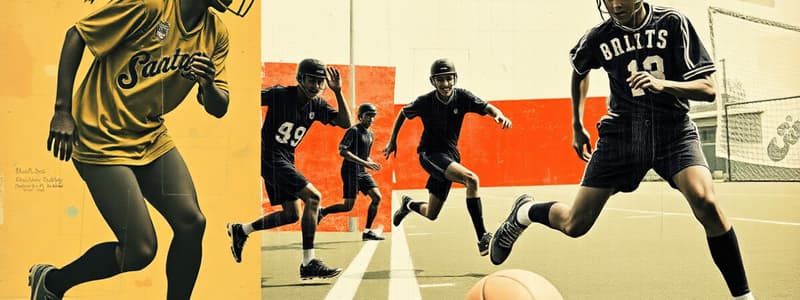Podcast
Questions and Answers
Participants should be encouraged to recognize and respond to pain or discomfort; this aligns with the general safety principle of listening to your ______.
Participants should be encouraged to recognize and respond to pain or discomfort; this aligns with the general safety principle of listening to your ______.
body
Prior to engaging in physical activities, it is critical to implement proper ______ and cool-down routines, which are essential for preparing the body and preventing injuries.
Prior to engaging in physical activities, it is critical to implement proper ______ and cool-down routines, which are essential for preparing the body and preventing injuries.
warm-up
To minimize the risk of overuse injuries, it is recommended to follow a principle of ______ progression by gradually increasing the intensity and duration of exercise.
To minimize the risk of overuse injuries, it is recommended to follow a principle of ______ progression by gradually increasing the intensity and duration of exercise.
gradual
To ensure equipment safety, regular ______ should be conducted to identify any damage or wear and tear that may compromise its integrity.
To ensure equipment safety, regular ______ should be conducted to identify any damage or wear and tear that may compromise its integrity.
Appropriate protective ______, such as helmets, pads, and eyewear, should be worn when necessary to mitigate the risk of injuries during physical activities.
Appropriate protective ______, such as helmets, pads, and eyewear, should be worn when necessary to mitigate the risk of injuries during physical activities.
The environment should be assessed for potential ______, such as uneven surfaces, obstacles, or weather conditions, to ensure the safety of participants.
The environment should be assessed for potential ______, such as uneven surfaces, obstacles, or weather conditions, to ensure the safety of participants.
Activities should be supervised by ______ personnel with appropriate training and experience to ensure the safety and well-being of participants.
Activities should be supervised by ______ personnel with appropriate training and experience to ensure the safety and well-being of participants.
To foster skill development and reduce the risk of injury, progressively challenging ______ should be designed to enhance participants' abilities.
To foster skill development and reduce the risk of injury, progressively challenging ______ should be designed to enhance participants' abilities.
A comprehensive ______ plan should be in place, outlining procedures for responding to injuries or other emergencies.
A comprehensive ______ plan should be in place, outlining procedures for responding to injuries or other emergencies.
Failure to provide reasonable care, resulting in injury, can lead to legal ______.
Failure to provide reasonable care, resulting in injury, can lead to legal ______.
[Blank] potential hazards and risks associated with sports and exercise activities is a crucial first step in maintaining safety.
[Blank] potential hazards and risks associated with sports and exercise activities is a crucial first step in maintaining safety.
Wearable sensors and other ______ devices can track physiological data and provide insights into potential risks during sports activities.
Wearable sensors and other ______ devices can track physiological data and provide insights into potential risks during sports activities.
To ensure they remain current and relevant, policies and procedures should be periodically ______ and updated.
To ensure they remain current and relevant, policies and procedures should be periodically ______ and updated.
Pre-______ screening involves medical evaluations to identify potential health risks before an individual participates in sports.
Pre-______ screening involves medical evaluations to identify potential health risks before an individual participates in sports.
Creating an environment where participants feel comfortable reporting concerns or injuries can be achieved by encouraging open ______.
Creating an environment where participants feel comfortable reporting concerns or injuries can be achieved by encouraging open ______.
Organizations can protect themselves from liability in certain situations by using ______.
Organizations can protect themselves from liability in certain situations by using ______.
A reliable ______ system should be in place to summon help if needed in case of emergencies during sports activities.
A reliable ______ system should be in place to summon help if needed in case of emergencies during sports activities.
Detailed plans for responding to various types of emergencies are known as emergency ______ plans.
Detailed plans for responding to various types of emergencies are known as emergency ______ plans.
Flashcards
Safety Awareness
Safety Awareness
Being aware of potential dangers and following established safety rules.
Warm-up and Cool-down
Warm-up and Cool-down
Preparing muscles for activity and gradually bringing the body back to a resting state.
Gradual Progression
Gradual Progression
Increasing exercise intensity and duration gradually to avoid overstressing the body.
Listen to Your Body
Listen to Your Body
Signup and view all the flashcards
Equipment Inspection
Equipment Inspection
Signup and view all the flashcards
Hazard Assessment
Hazard Assessment
Signup and view all the flashcards
Qualified Supervision
Qualified Supervision
Signup and view all the flashcards
Skill-Appropriate Activities
Skill-Appropriate Activities
Signup and view all the flashcards
Emergency plan
Emergency plan
Signup and view all the flashcards
Negligence
Negligence
Signup and view all the flashcards
Informed consent
Informed consent
Signup and view all the flashcards
Assumption of risk
Assumption of risk
Signup and view all the flashcards
Risk management
Risk management
Signup and view all the flashcards
Monitoring and Evaluation
Monitoring and Evaluation
Signup and view all the flashcards
Promote a Culture of Safety
Promote a Culture of Safety
Signup and view all the flashcards
Role of Technology in Safety
Role of Technology in Safety
Signup and view all the flashcards
Standardized protocols
Standardized protocols
Signup and view all the flashcards
Pre-participation screening
Pre-participation screening
Signup and view all the flashcards
Study Notes
- Physical Education (PE) and sports activities are crucial for health, but they carry inherent risks.
- Safety practices are essential to minimize injuries and ensure a positive experience.
- These practices encompass various areas, including equipment, environment, supervision, and emergency procedures.
General Safety Principles
- Participants should be educated about potential risks and safe practices via education and awareness programs.
- Proper warm-up and cool-down routines are essential to prepare the body for activity and prevent injuries.
- Gradually increasing the intensity and duration of exercise minimizes the risk of overuse injuries.
- Participants should be encouraged to recognize and respond to pain or discomfort by listening to their bodies.
- Maintaining proper hydration and nutrition is crucial for performance and recovery.
Equipment Safety
- Equipment should be regularly inspected for damage or wear and tear.
- Equipment should be properly maintained and repaired as needed.
- Participants should be trained on the correct use of equipment.
- Appropriate protective gear, such as helmets, pads, and eyewear, should be worn when necessary.
- Using equipment that meets safety standards and certifications can reduce risk.
Environmental Safety
- The environment should be assessed for potential hazards, such as uneven surfaces, obstacles, or weather conditions.
- Playing surfaces should be well-maintained and free of hazards.
- Weather conditions should be monitored, and activities should be modified or postponed if necessary.
- Adequate lighting should be provided for activities conducted in low-light conditions.
- Maintaining a comfortable temperature in indoor facilities is important.
Supervision and Instruction
- Activities should be supervised by qualified personnel with appropriate training and experience.
- Participants should receive clear and concise instructions on how to perform activities safely.
- Activities should be matched to the skill level and experience of participants.
- Progressively challenging drills should be designed to improve skills and reduce the risk of injury.
- Modifying rules to reduce the risk of collisions or other injuries may be necessary.
Emergency Procedures
- A comprehensive emergency plan should be in place, outlining procedures for responding to injuries or other emergencies.
- Readily accessible first aid supplies should be available.
- Personnel trained in first aid and CPR should be present.
- A reliable communication system should be in place to summon help if needed.
- All incidents should be reported and documented.
Specific Sports and Activities
- Each sport and activity has unique safety considerations.
- Understanding these specific risks is essential for injury prevention.
- Basketball: Ankle sprains, knee injuries, concussions are common.
- Soccer: Ankle sprains, knee injuries, concussions are common.
- Football: Concussions, fractures, ligament tears are common.
- Gymnastics: Sprains, fractures, dislocations are common.
- Swimming: Drowning, near-drowning, hypothermia are some of the risks.
Legal Considerations
- Failure to provide reasonable care, resulting in injury, can lead to legal liability, termed as Negligence.
- Participants (or their guardians) should be informed of the risks involved in an activity and provide consent to participate, called informed consent.
- Participants acknowledge that they understand the risks involved in an activity with Assumption of risk.
- Waivers can protect organizations from liability in certain situations.
- Adequate insurance coverage is essential.
Risk Management
- Identify potential hazards and risks associated with sports and exercise activities through Identification.
- Assessment involves gauging the likelihood and severity of each risk.
- Control involves implementing strategies to control or eliminate risks.
- Monitoring requires regularly tracking the effectiveness of risk management strategies.
- Evaluation covers the appraisal of the risk management program overall, with adjustments made where needed.
Creating a Safe Environment
- Emphasize the importance of safety among participants, coaches, and staff to promote a culture of safety.
- Encourage open communication, creating an environment where participants feel comfortable reporting concerns or injuries.
- Consistently enforce safety rules and procedures.
- Provide ongoing training for coaches, staff, and participants on safety practices.
- Safety protocols should be regularly reviewed and updated to reflect current best practices.
Role of Technology in Safety
- Wearable sensors and other monitoring devices can track physiological data and provide insights into potential risks.
- Video analysis can be used to identify unsafe techniques or practices.
- Virtual reality can be used to simulate potentially dangerous situations and train participants on how to respond.
- Injury tracking systems can be used to identify patterns and trends in injuries and inform prevention efforts.
- Mobile apps and other communication platforms can disseminate safety information and facilitate communication during emergencies.
Importance of Policy and Procedures
- Establish clear and consistent guidelines for all activities via Standardized protocols.
- Maintain records of safety inspections, incident reports, and training sessions through Documentation
- Emergency action plans involve developing detailed plans for responding to various types of emergencies.
- Implement effective Communication strategies to disseminate safety information.
- Policies and procedures should undergo Periodic review to ensure they remain current and effective.
Health Considerations
- Pre-participation screening: Medical evaluations to identify potential health risks before participation.
- Management of chronic conditions: Strategies for managing conditions like asthma, diabetes, and allergies.
- Prevention of heat-related illnesses: Guidelines for preventing heat exhaustion and heat stroke.
- Concussion management: Protocols for recognizing, evaluating, and managing concussions.
- Mental health support: Resources for addressing mental health concerns related to sports and exercise.
Studying That Suits You
Use AI to generate personalized quizzes and flashcards to suit your learning preferences.
Description
Discover essential safety practices for physical education and sports. Learn about general safety principles, including warm-up, cool-down, and hydration. Understand equipment safety, environmental considerations, supervision, and emergency procedures to minimize risks and maximize positive experiences.




